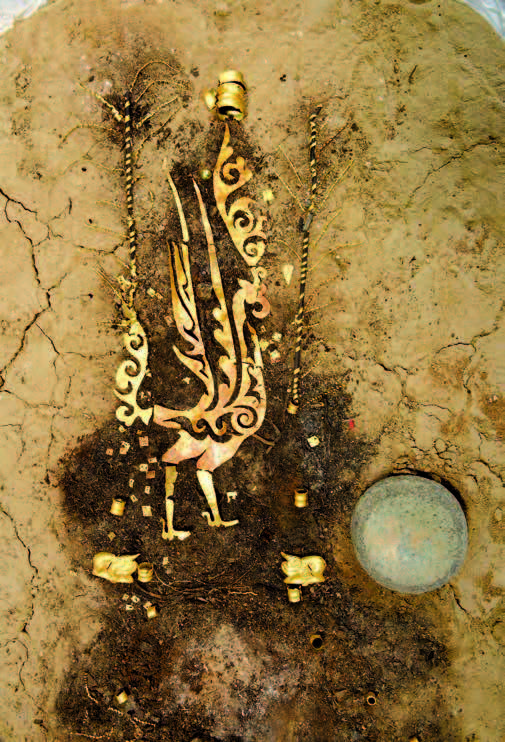URZHAR MOUND: HISTORY OF DISCOVERY AND SOME RESEARCH RESULTS
DOI:
https://doi.org/10.52967/akz2019.2.4.9.22Keywords:
archaeology, mound, burial, culture, nomads, headdressAbstract
The article proposes a preliminary report on the Urzhar mound that was not pillaged with a female burial identified in 2013 during protection works carried out in connection with reconstruction of Taskesken – Bakhty highway in Urzhar district of East Kazakhstan
region. The monument is unique with preserved headdress of extraordinary burial, which can be completely reconstructed. The burial is solitary, performed in a stone box. As elements of accompanying complex, there are remains of sacrificial food in the form of animal bones, ceramic and wooden utensils, and a stone-like item like an altar. From jewelry, an earring with a stone pendant was preserved. In the 14 C dating laboratory, a calibrated date was obtained. The mound dates back to V-IV centuries BC. The materials of the monument were analyzed by a group of specialists, including paleoanthropologists, geneticists, biologists, and palynologists. Currently, the study of the materials from the Urzhar mound continues.
References
Akishev, K. A. 1978. Kurgan Issyik: iskusstvo sakov Kazahstana (Kurgan Issyk: the art of the Sakas of Kazakhstan). Moscow: “Iskusstvo” Publ. (in Russian).
Altynbekov, K. 2018. Urzharskaya zhritsa: istoriya vozrozhdeniya unikalnoi nahodki (Urjar priestess: the story of the revival of a unique find). Almaty: “Ostrov Krym” Publ. (in Russian).
Baitanayev, B. A., Kitov, E. P. 2016. In Baitanayev, B. A. (ed.). Kulturnoe nasledie Evrazii (s drevnosti do nashih dney) (Cultural heritage of Eurasia (from antiquity to the present day)). Almaty: A.Kh. Margulan Institute of Archeology, 722–729 (in Russian).
Jansugurova, L. B., Baitanayev, B. A., Khusainova, E. M., Nurjibek, Junusova, G. S., Iksan, O. A., Jantayeva, K. B., Kitov, E. P. 2016. In Baitanayev, B. A. (ed.). Kulturnoe nasledie Evrazii (s drevnosti do nashih dney) (Cultural heritage of Eurasia (from antiquity to the present day)). Almaty: A.Kh. Margulan Institute of Archeology, 698–711 (in Russian).
Kiryushin, Yu. F., Stepanova, N. F. 2004. Skifskaya epoha Gornogo Altaya. Ch. III: Pogrebalnyie kompleksyi skifskogo vremeni Sredney Katuni (The Scythian Era of Altay. Part III: The funerary complexes of the Scythian time of the Middle Katun). Barnaul: Altay State University Publ. (in Russian).
Kubarev, V. D. 1991. Kurgany Yustyda (Yustyd mounds). Novosibirsk: “Nauka” Publ. (in Russian).
Provedenie issledovatelskih rabot po teme: «Arheologicheskie izyiskaniya na uchastke rekonstruktsii avtomobilnoy dorogi “Taskesken-Bahtyi (granitsa KNR)“ 20-60 i mosta cherez reku Karakol v Vostochno-Kazahstanskoy oblasti» (Conducting research work on the topic: “Archaeological surveys at the site of reconstruction of the“ Taskesken-Bakhty highway ”(border of the People’s Republic of China)“ 20-60 and the bridge over the Karakol River in the East Kazakhstan region ”). In the archive of the A.Kh. Margulan Institute of Archaeology, 2-f. 55-c. 3167-f. (in Russian)
Samashev, Z. 2011. Berel. Almaty: “Taymas” Publ. (in Russian).
Shulga, P. I. 2003. Mogilnik skifskogo vremeni Lokot-4a (Burial ground of the Scythian time Lokot-4a). Barnaul: Altay State University Publ. (in Russian).
Shulga, P. I. 2016. In Derevyanko, A. P., Molodin, V. I. (eds.). Altay v krugu evraziyskih drevnostey (Altay in the circle of Eurasian antiquities). Novosibirsk: Institute of Archeology and Ethnology of the SB RAN, 253–272 (in Russian).
Reimer, P. J, Bard, E., Bayliss A, et al. 2013. In Radiocarbon, 55 (4), 1869–1887.

Downloads
Published
How to Cite
Issue
Section
License
Copyright (c) 2019 B.A. Baitanayev

This work is licensed under a Creative Commons Attribution-NonCommercial 4.0 International License.






